Her Football Hub
·23 May 2022
UWCL analysis: How Lyon’s compact defending stopped Barcelona

In partnership with
Yahoo sportsHer Football Hub
·23 May 2022

We are all recuperating and recovering from the exciting UWCL final between Olympique Lyonnais and FC Barcelona. The French outfit deservedly won and regained control of the European hegemony they have established over the years. While the attacking efficiency sealed the deal for Olympique Lyonnais, it was the defensive display that put a hold on Barcelona’s attacking prowess.
This analysis will focus on the defensive organisation of Lyon and how they dealt with the attacks, employed by Barcelona in the first half. The data and images are from Wyscout.
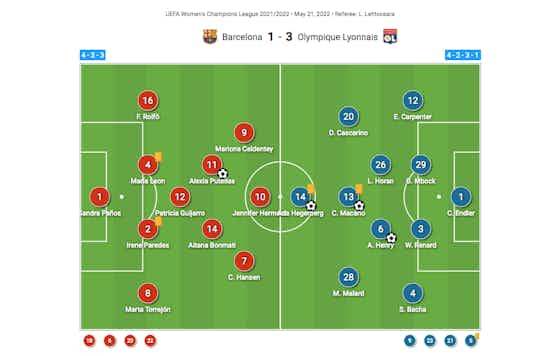
Line-ups. Credit: Wyscout
Barcelona started with a 4-3-3 formation with a back four of Rolfö-Leon-Pared-Torrejon, but with the emphasis to go forward a lot in attack, which we saw with Rolfö occupying the left flank, effectively being a wing-back. Putellas and Bonmati were concerned with playmaking and creating from the midfield, while Guijarro was the sole defensive midfielder – joining the back four in the defensive phases. Hansen and Caldentey played on the flanks, while Hermoso played as the striker. The latter was the striker but did assume a role where she dropped deeper, creating space for Putellas to drop in that particular zone.
Lyon did start with a slightly different formation. They started with a 4-2-3-1 formation with a back four of Bacha-Renard-Mbock-Carpenter. Carpenter was subbed early on for Buchanan. The midfield consisted of two parts. The defensive low block or the double pivot of Henry-Horan, and the attacking part of Malard-Macario-Cascarino. The idea was that the wide midfielders were wingers in attack, but trailed back in the state of defence. Hegerberg was the sole striker but was very much assisted by the two wide midfielders and Macario who played as a #10.
Barcelona is a heavy possession-based team and want to create chances/goalscoring opportunities from a passing style of play. They want to have everyone involved in play and this is the core principle of their play: dominating possession and via passing, converting that into chances.
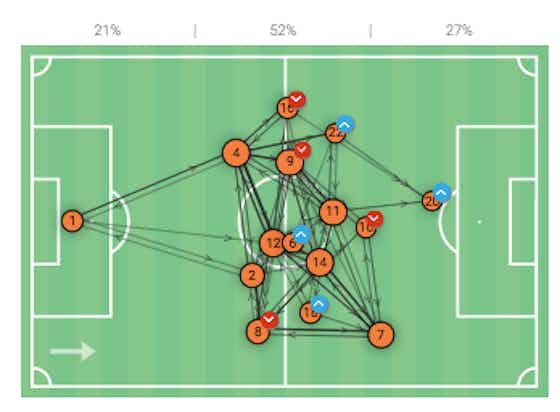
Pass network Barcelona. Credit: Wyscout
As you can see in the pass network above, that passing style led to the fact that most of the passes were conducted in the middle third (52%), then the attacking third (27%), and only 21% in their own defensive third. With 535 passes played (81% successful), it’s evident that Barcelona wants to use possession to dominate the middle third.
Barcelona had a very distinct way of how they constructed its attacks. The first one was by regaining possession by the midfield trio, who played very compact and close to each other.
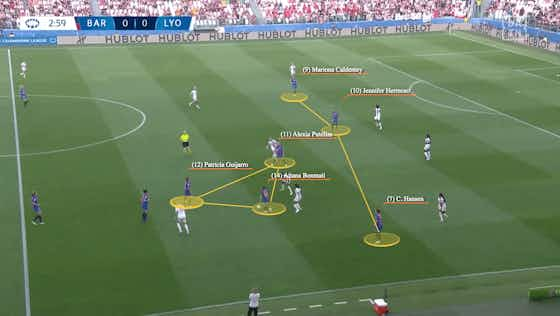
Credit: Wyscout
After regaining possession of the ball, we see that Guijarro, Bonmati, and Putellas play close to each other. Putellas is the one making play and creating chances, closest to the striker. Bonmati is the one with the ball and progressing via runs and dribbles, while Guijarro does the controlling in the midfield. While staying compact and drawing Lyon players in doing so, they stretch the front three – forcing the defenders to make a move. That’s how they wanted to beat Lyon in attack.
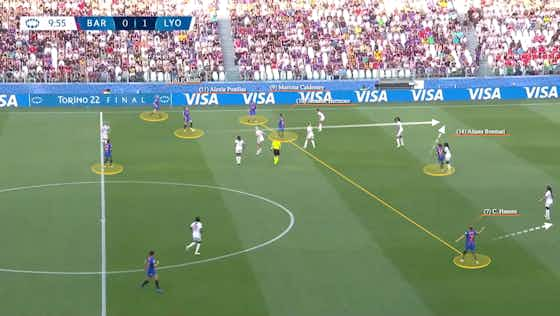
Credit: Wyscout
In the image above you see another example of how Barcelona wanted to get possession of the ball and stay compact while stretching the front three. By being compact and having numbers in a certain area (Rolfö-Putellas-Caldentey-Hermoso) – they could open up passing lanes and runs. Hansen stretches play and opens up space for Bonmati to run behind the lanes and get dangerous.
Lyon had a different approach as they wanted to play in a compact defence and hurt Barcelona on the counter-attacks. This is illustrated by their pass network.
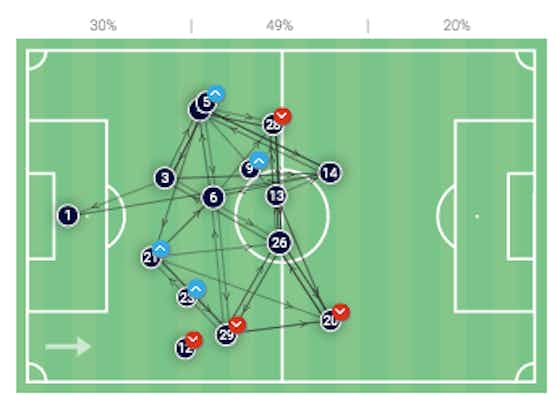
Credit: Wyscout
As you can see in the image they are relatively deeper in their actions with 30% in their own defensive third, 49% in the middle third, and 20% in the attacking third. They frustrated Barcelona with their defensive lines, but how did they do it?
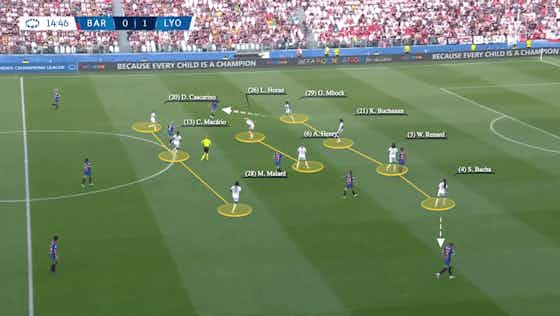
Credit: Wyscout
When defending deep, as Barcelona is in the middle third, Lyon employed their three defensive lines. The back four with the central defensive duo marking Hermoso and the full-backs Bacha and Mbock, tasked with marking Hansen and Caldentey. Horan and Henry should mark the two most progressive midfielders: Putellas and Bonmati, while the attacking midfielders would take care of Barcelona’s defensive midfielder or progressing central defender.

Credit: Wyscout
When Barcelona started the attack from the back, the lines in defence changed. The defensive midfield and the attacking midfield joined forces and formed a 4-5-1 formation with Hegerberg on top. In doing so they wanted to gives as little space as possible to the passing playmakers Guijarro and Bonmati. And, isolate the attackers.
Barcelona’s attack is famous for its good use of passing and positioning, but that couldn’t be seen in the first half of the UWCL final, which was decisive for the outcome of the game. While Barcelona tried to compact the midfield and stretch the attack, Lyon was set up defensively solid.
The deep defensive lines in the 4-2-3-1 formation allowed for little creativity on the flanks. When Barcelona had to construct the attacks from their own defensive third, Lyon’s defence frustrated them. The 4-5-1 formation made sure the creative players were isolated and the attacking positioning became useless.






























































